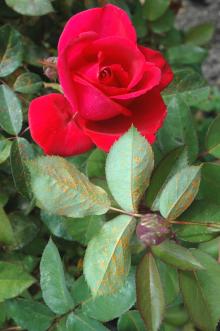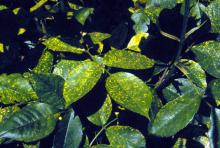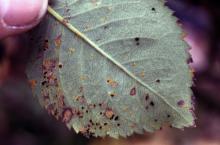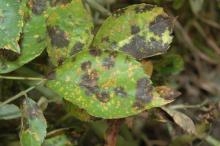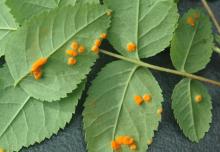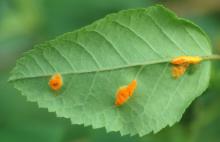See:
Cause Phragmidium sp., nine species of autoecious (can complete their life cycle on this one host) fungi that are found throughout the Pacific Northwest. They overwinter on diseased leaves and stems. Wind blows spores to healthy foliage. They germinate and infect through the stomata when leaves are wet for 2 to 4 hours. Mild, humid weather favors disease development.
Symptoms Small orange pustules (aecia) appear early in spring on both leaf surfaces. Later, the pustules enlarge and become more numerous on lower leaf surfaces. Mottled and chlorotic areas may develop on upper leaf surfaces opposite the spots (uredinia) on the lower surfaces. In late summer and fall, the small pustules turn black (telia) and contain the winter spore stages of the rust. Stems occasionally are infected.
Cultural control
- Rake up all dead leaves and prune out infected and dead wood during the dormant season.
- Plant resistant cultivars.
- Removing infected leaves early in the season may be effective in some home gardens.
Chemical control Focus applications during the spring when mostly wet weather transitions into mostly dry weather. Wetting agents will help with many of these fungicides if allowed by the label. Many fungicides used for black spot will be helpful to control rust.
Products available in home packaging:
- BioAdvanced Disease Control at 0.75 fl oz/gal water. Group 3 fungicide. H
- Ortho Rose & Flower Disease Control at 2 fl oz/gal water. Group 3 fungicide. H
- Spectracide Immunox Multi-Purpose Fungicide Spray Concentrate for Gardens at 1 oz/gal water. Group 3 fungicide. H
Products available for commercial use:
- A dormant spray of one of the following, then fungicides during the growing season.
- Bordeaux 8-8-100. Group M1 fungicide.
- Sulforix at 1.5 pints/100 gal water. 48-hr reentry.
- Armada 50 WDG at 3 to 9 oz/100 gal water. Do not use a silicone-based surfactant. Not for nursery or greenhouse use. Group 3 + 11 fungicide. 12-hr reentry.
- Broadform at 4 to 8 fl oz/100 gal water. Group 7 + 11 fungicide. 12-hr reentry.
- Compass 50 WDG at 2 to 4 oz/100 gal water. Do not use organosilicate additives. Group 11 fungicide. 12-hr reentry.
- Eagle 20 EW at 6 to 12 fl oz/100 gal water. Group 3 fungicide. 24-hr reentry.
- Fame SC at 1 to 4 fl oz/100 gal water. Group 11 fungicide. 12-hr reentry.
- Heritage at 2 to 4 oz/100 gal water plus a non-silicone-based wetter sticker. Heritage can also be used at 1.6 to 8 oz/A for commercial rose production. Group 11 fungicide. 4-hr reentry.
- Mancozeb-based products. Group M3 fungicides. 24-hr reentry.
- Fore 80 WP at 1.5 lb/100 gal water plus a spreader-sticker.
- Protect DF at 1 to 2 lb/100 gal water plus 2 to 4 oz spreader-sticker.
- Monsoon Turf at 4 to 10 fl oz/100 gal water. Group 3 fungicide. 12-hr reentry.
- Myclobutanil 20 EW T&O at 6 to 12 fl oz/100 gal water plus spreading agent. May observe a PGR effect. Group 3 fungicide. 24-hr reentry.
- Pageant at 6 to 12 oz/100 gal water. Do not use with organosilicone-based adjuvants. Group 7 + 11 fungicide. 12-hr reentry.
- Propiconazole-based products. Field-grown roses only. Group 3 fungicides.
- Banner MAXX at 5 to 8 fl oz/100 gal water. 12-hr reentry.
- Fitness at 1.8 to 3 fl oz/100 gal water. 12-hr reentry.
- ProCon-Z at 5 to 8 oz/100 gal water. 24-hr reentry.
- Strider at 5 to 8 fl oz/100 gal water. 12-hr reentry.
- ProStar 70 WG at 3 to 6 oz/100 gal water. Group 7 fungicide. 12-hr reentry.
- Tebuzol 3.6F at 4 to 10 fl oz/100 gal water. Group 3 fungicide. No reentry interval listed.
- Torque at 4 to 10 fl oz/100 gal water. Group 3 fungicide. 12-hr reentry.
Biological control
- Sonata (Bacillus pumilis strain QST 2808) at 2 to 4 quarts/A plus a surfactant. Efficacy in the Pacific Northwest is unknown. 4-hr reentry. O
Reference Horst, R.K. and Cloyd, R.A. 2007. Compendium of Rose Diseases and Pests. Second Edition. APS Press. St. Paul, MN.


